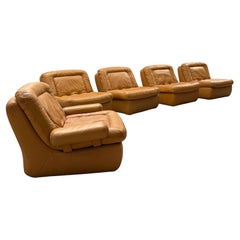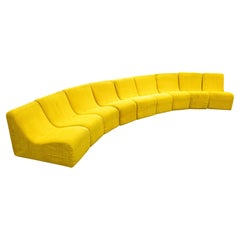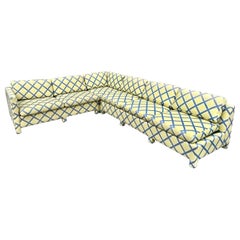Yellow 1970s Sectional
Vintage 1970s German Mid-Century Modern Living Room Sets
Leather
Recent Sales
Vintage 1970s American Modern Sectional Sofas
Fabric, Wood
Mid-20th Century American Mid-Century Modern Sectional Sofas
Textile
Vintage 1970s American Sectional Sofas
Yellow 1970s Sectional For Sale on 1stDibs
How Much is a Yellow 1970s Sectional?
Finding the Right Sectional-sofas for You
An antique, new or vintage sectional sofa is a versatile and practical style of seating that makes for a great addition to your living space.
A traditional sofa is typically a long upholstered seat that features a back and arms and is intended for two or more people, whereas a sectional sofa consists of multiple pieces that can be arranged in several different layouts. While a conventional couch or sofa can definitely seat a fixed number of houseguests, sectional sofas allow for customizing. We all know that maximizing your square footage in a small space can prove difficult, so the modular characteristics of sectional sofas are especially appealing when you’re thinking about design ideas for your modest-sized living room. This furnishing can be arranged in a semicircle, an L-shape or other configuration and will seat more people than a standard sofa will.
When it comes to home decor, the trick is to find a balance between functionality and style. Sectional sofas are available in a wide variety of shapes, sizes, colors and fabric options, so you’re sure to find one that perfectly complements your interiors and needs. But there are several factors to consider when choosing the perfect sectional sofa for your space.
According to Charleston designer Angie Hranowsky, “the most important thing to know when choosing the perfect sofa is its purpose. Is it for conversation or for watching TV and lounging? Then you can determine the right depth and seat height.”
The size of your sectional sofa will depend on how much real estate you’re working with in your living room and exactly how you use the space. If you’re trying to define a common area in your sprawling loft apartment or you’ve got a large family to think about, a large, sleek contemporary sectional or sculptural sectional sofa designed by Milo Baughman, say, could be ideal for comfort as well as a conversation piece, particularly if you intend to entertain with regularity. Think about seat height and depth — high seats, for example, can yield an air of formality that might not be a great fit for your crowd.
For movie nights, holiday parties or the occasional but totally fabulous dinner party, a large sectional sofa means getting multiple uses out of a singular piece of seating. In smaller rooms, it might make sense to position your small sectional sofa against the wall, whereas in a wide-open space, the sofa’s components can occupy the center of the room. Measure accordingly and make sure your doorways can accommodate on delivery day.
Bring comfort and class to your living space with a sectional sofa from the world’s best dealers on 1stDibs. For your mid-century modern-inspired living room, find fun spage-age sectional sofas, chic leather sectional sofas and a range of vintage mid-century sectional sofas designed by the likes of Harvey Probber, Vladimir Kagan and others.
- What was worn in the 1970s?1 Answer1stDibs ExpertFebruary 22, 2021Fashion during the 1970s included lots of T-shirts, cardigans, kimonos, graphic tees, jeans, khakis, and vintage clothes. In the mid-1970s, other fashion highlights included puffy skirts and shirts with flowy sleeves.
- 1stDibs ExpertApril 5, 2022Yes, sequins were indeed popular in the 1970s and could be seen on the dancefloors and discos of the time, along with other popular fabrics like velvet and satin. Sequins and hot pants were the go-to outfit of the disco-glam decade. Shop iconic vintage and contemporary sequin clothing from some of the world’s top boutiques on 1stDibs.
- Was velvet used in the 1970s?1 Answer1stDibs ExpertJune 15, 2023Yes, velvet was used in the 1970s. Fashion designers used the fabric to produce dresses, bell bottoms, flowy kimonos and other pieces. Furniture makers often used it as the upholstery on sofas and armchairs. On 1stDibs, shop a variety of pieces from the 1970s.
- Are the 1970s mid-century?1 Answer1stDibs ExpertFebruary 17, 2023No, the 1970s are generally not considered to fall within the era identified as mid-century. With respect to mid-century modern design, while there is some debate between collectors and design experts about the specific time period that saw the emergence of the style, most furniture enthusiasts agree that by the late 1960s, interest in MCM had largely declined. Writer Cara Greenberg, who coined the term “mid-century modernism,” suggests that “the period from the end of World War II to 1960 – from V-J Day to JFK – was the heyday of innovative furniture design in America.” Mid-century modern furniture is characterized by clean lines and inviting, organic shapes. Furniture makers of the era believed that good design was an essential part of good living. Find a variety of vintage mid-century modern furniture and decorative objects on 1stDibs.
- What is 1970s furniture called?1 Answer1stDibs ExpertMarch 15, 2024What 1970s furniture is called varies. Generally, you may see pieces produced during the decade classified as "vintage" or "retro" furniture. During the 1970s, some makers continued to produce furniture that boasted the characteristics of mid-century modern works. The disco era yielded furnishings with organic, often rounded shapes, unadorned silhouettes, clean lines and a mix of materials. The showy leather furniture of the 1970s, which was both sexy and comfortable, is seeing a resurgence in today’s homes. Shop a wide variety of vintage 1970s furniture on 1stDibs.
- 1stDibs ExpertApril 5, 2022To tell if a dress is from the 1960s or 1970s, first look for a label. You may be able to determine the approximate date of the dress simply by researching the designer using reputable online sources. Also, check the zippers. Dresses from the 1960s will usually have metal or nylon zippers. Ones from the 1970s are more likely to be plastic. You'll find a large selection of vintage dresses on 1stDibs.
- 1stDibs ExpertApril 5, 2022Go-go boots were fashionable in the late 1960s through the 1970s. A calf-length to knee-length boot became synonymous with 1960s and 1970s fashion and is still highly coveted today by fashion enthusiasts. Shop a wide range of vintage go-go boots on 1stDibs.
- 1stDibs ExpertMay 5, 2023Which clothing style was most popular in the discos in the 1970s is open to debate. Some of the trends of the discotheque scene included sleeveless, sequined tops paired with bell bottoms and knee-length halter dresses topped off with tall go-go boots. For men, jumpsuits and leisure suits were the favorite looks. Both men and women often wore shoes with chunky heels and thick platforms. On 1stDibs, find an assortment of 1970s vintage clothing and accessories.
- 1stDibs ExpertJanuary 27, 2025The designer who became famous with her wrap dresses in the 1970s is Diane von Furstenberg. She debuted her first example in 1974. When creating the Wrap dress, von Furstenberg drew inspiration from the skirts worn by ballerinas. In celebration of the 40th anniversary of the now-iconic dress, an exhibit called Diane von Furstenberg: Journey of a Dress was held at museums in the United States and abroad. On 1stDibs, explore a range of Diane von Furstenberg apparel and accessories.
- 1stDibs ExpertApril 5, 2022After the success of his “Sol” series in the 1960s, Richard Anuszkiewicz began to focus on his “Centered Square” designs in the mid-1970s. He used interacting colors to change the perception of the art in the eye of the viewer. You can shop a selection of Richard Anuszkiewicz pieces from some of the world’s top art dealers on 1stDibs.
Read More
All the Furniture in This Organic Modern Soho Loft Can Be Yours
Andrianna Shamaris has filled her epic new home with pieces of her own design.
20 Inviting Dining Rooms Perfectly Arranged for Entertaining
Top interior designers show — and tell — us how to create delectable spaces for hosting dinner parties.
Nobody Puts This Sunny Sofa in a Corner
With its plush cushions, cane details and dazzlingly colorful back, it’s inviting from every angle.
The 21 Most Popular Mid-Century Modern Chairs
You know the designs, now get the stories about how they came to be.
Fred Rigby’s Modular Seating Can Be Configured in So Many Handy Ways
The plush Cove Slipper 2.5 Seater sofa is just one of many convenient combinations from the London-based maker.
This Chubby-Chic Quilted Stool Stands on Its Own Two Feet
Sam Klemick's cool stool is edgy, cozy and environmentally sustainable all at once.
Is Lionel Jadot the Willy Wonka of Upcycled Belgian Design?
From his massive collaborative workshop in a former paper factory, the designer concocts funky furniture from disused materials, as well as luxe hotel interiors like the new Mix Brussels.
Rock Your Cares Away on This Sunny Hand-Crocheted Swing
The boho-chic Enchanted Forest Swing, handmade by marginalized women from Turkey and Syria, is uplifting in every way.


